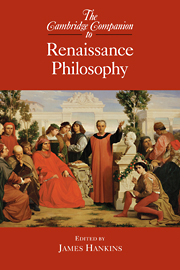Book contents
- Frontmatter
- 1 Introduction
- Part I Continuity and Revival
- Part II Toward Modern Philosophy
- 9 Nicholas of Cusa and modern philosophy
- 10 Lorenzo Valla and the rise of humanist dialectic
- 11 The immortality of the soul
- 12 Philosophy and the crisis of religion
- 13 Hispanic scholastic philosophy
- 14 New visions of the cosmos
- 15 Organizations of knowledge
- 16 Humanistic and scholastic ethics
- 17 The problem of the prince
- 18 The significance of Renaissance philosophy
- Appendix: Brief biographies of Renaissance philosophers
- Bibliography
- Index
15 - Organizations of knowledge
from Part II - Toward Modern Philosophy
Published online by Cambridge University Press: 28 November 2007
- Frontmatter
- 1 Introduction
- Part I Continuity and Revival
- Part II Toward Modern Philosophy
- 9 Nicholas of Cusa and modern philosophy
- 10 Lorenzo Valla and the rise of humanist dialectic
- 11 The immortality of the soul
- 12 Philosophy and the crisis of religion
- 13 Hispanic scholastic philosophy
- 14 New visions of the cosmos
- 15 Organizations of knowledge
- 16 Humanistic and scholastic ethics
- 17 The problem of the prince
- 18 The significance of Renaissance philosophy
- Appendix: Brief biographies of Renaissance philosophers
- Bibliography
- Index
Summary
The “organization of knowledge” is a large and diffuse topic which can be studied at many different levels, ranging from the way an individual orders his or her understanding of the world privately or in publications, to the ways in which communities or institutions order knowledge, notably in pedagogical curricula and textbooks, professional structures, libraries and library catalogs, and other collective projects. Although a few modern philosophers have addressed the problem of classifying knowledge, current practices of classification are mostly studied by anthropologists and sociologists. Modern cultures and subcultures engage in both explicit and tacit classifications of knowledge, but today any particular organization of knowledge is generally acknowledged to involve a number of arbitrary choices and its success is often measured by pragmatic criteria of effectiveness, such as ease of use and economic efficiency. But this skeptical attitude toward the possibility of any organization matching the reality of knowledge or of the world is a fairly modern development, articulated for example in Jean Le Rond d’Alembert’s “preliminary discourse” to the Encyclopédie of 1751.
In Renaissance Europe, on the contrary, many thinkers harbored the ambition of implementing the perfect organization of knowledge, though pragmatic, notably alphabetical, arrangements were also widespread in certain contexts. During the Renaissance the difficulty of ordering knowledge was greatly exacerbated in almost every field by the massive influx of material to be included, stemming from newly discovered worlds and newly recovered ancient texts as well as newly printed texts of all kinds, and by concurrent social and cultural changes associated with the development of printing, a rapid growth in higher education, and shifting patterns of patronage and social mobility.
- Type
- Chapter
- Information
- The Cambridge Companion to Renaissance Philosophy , pp. 287 - 303Publisher: Cambridge University PressPrint publication year: 2007
- 11
- Cited by

